Wesley's Coursework 1: Audi VRIO Analysis in China Market Presentation
VerifiedAdded on 2022/08/10
|17
|808
|11
Presentation
AI Summary
This coursework presents a VRIO analysis of Audi in the Chinese market, examining its valuable, rare, inimitable, and organized resources. The analysis incorporates PESTEL and 5 Forces frameworks and links to a SWOT analysis to assess Audi's competitive position. The presentation provides evidence to support the assessment, including a comparison with competitors BMW and Mercedes, highlighting areas where Audi lags. The analysis discusses the sustainability of Audi's strategies in the Chinese market. The findings suggest that Audi faces challenges in the Chinese market compared to its competitors. The presentation includes references to support the analysis.
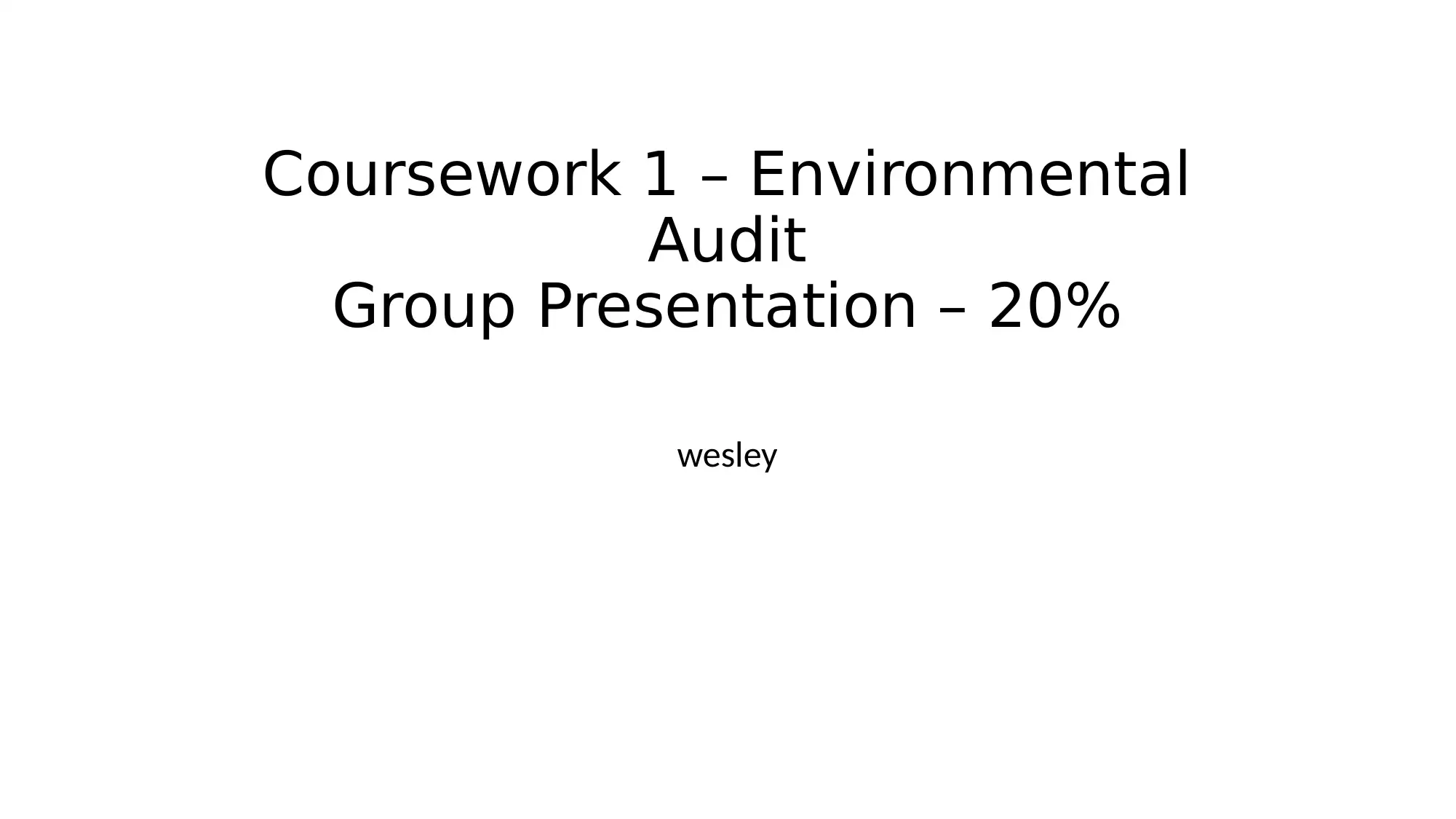
Coursework 1 – Environmental
Audit
Group Presentation – 20%
wesley
Audit
Group Presentation – 20%
wesley
Paraphrase This Document
Need a fresh take? Get an instant paraphrase of this document with our AI Paraphraser
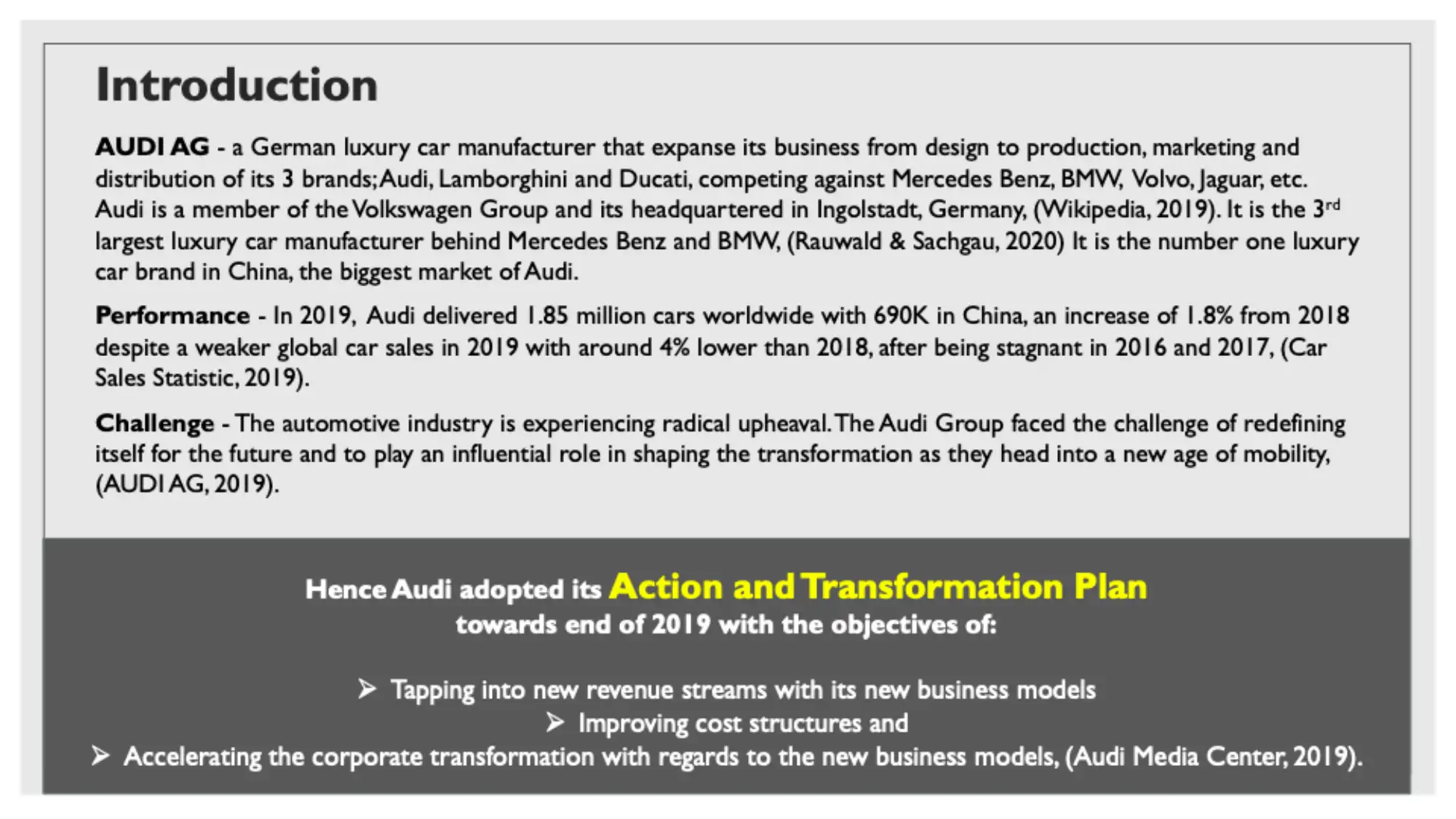
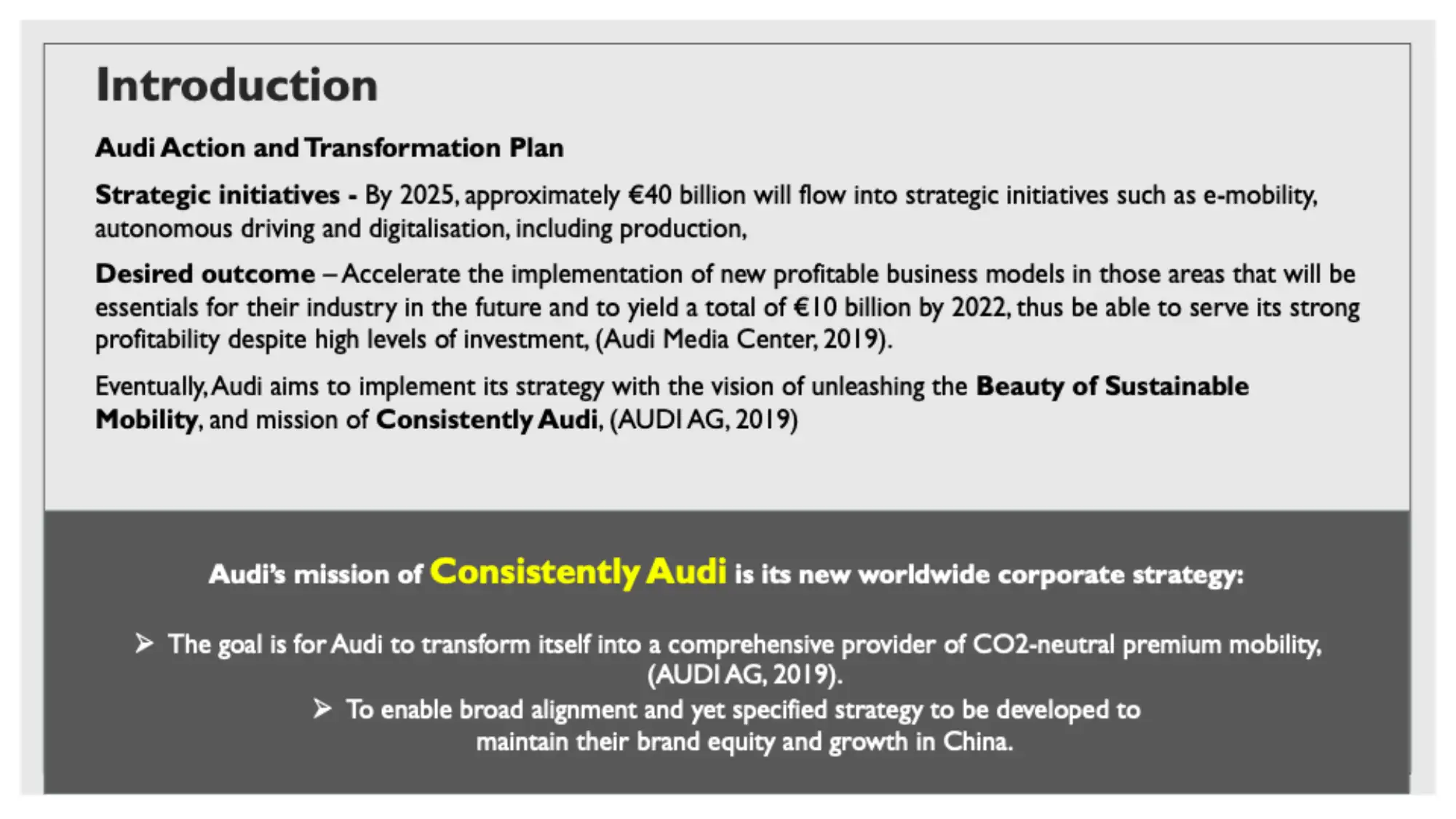
⊘ This is a preview!⊘
Do you want full access?
Subscribe today to unlock all pages.

Trusted by 1+ million students worldwide
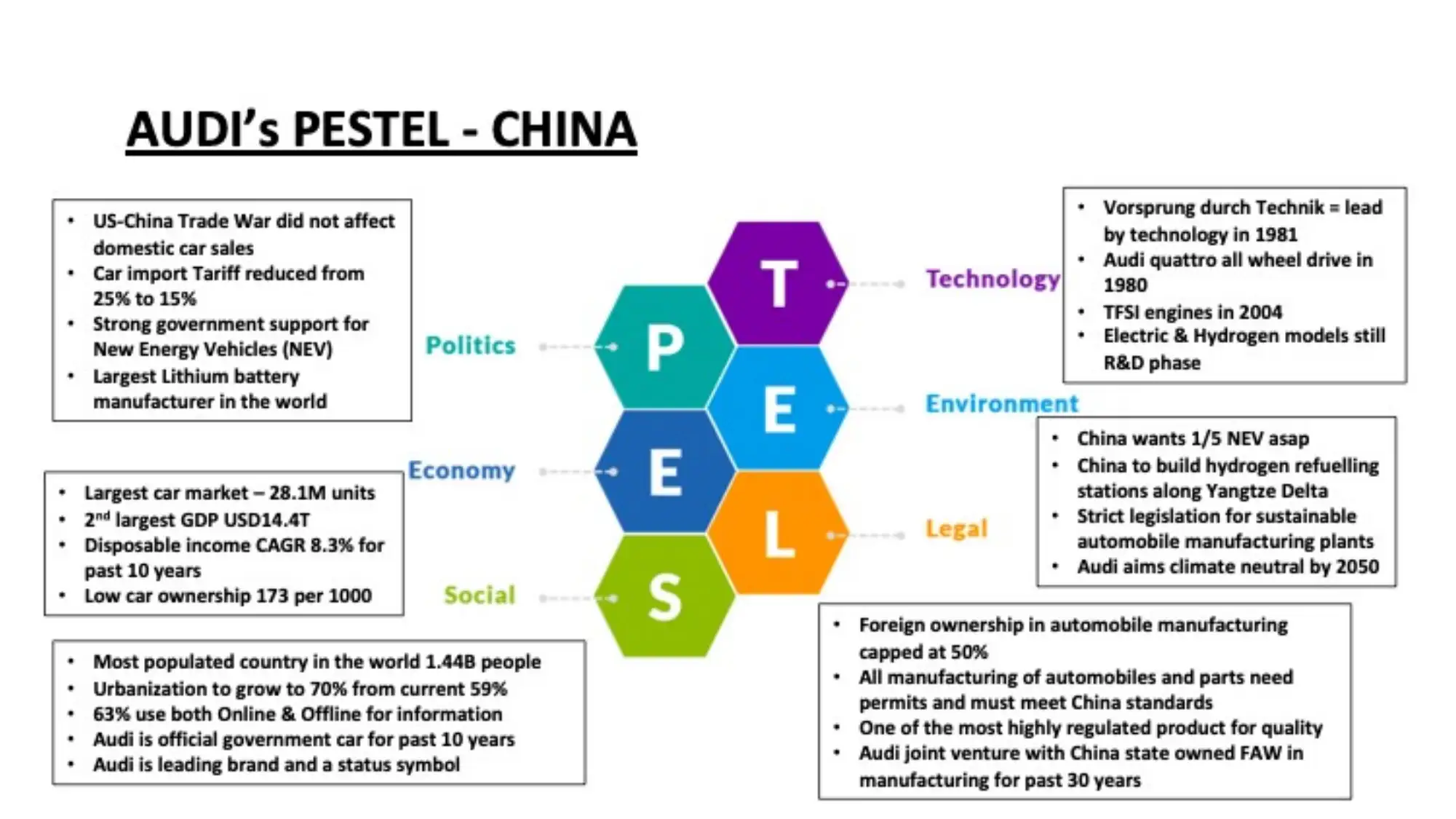
Paraphrase This Document
Need a fresh take? Get an instant paraphrase of this document with our AI Paraphraser
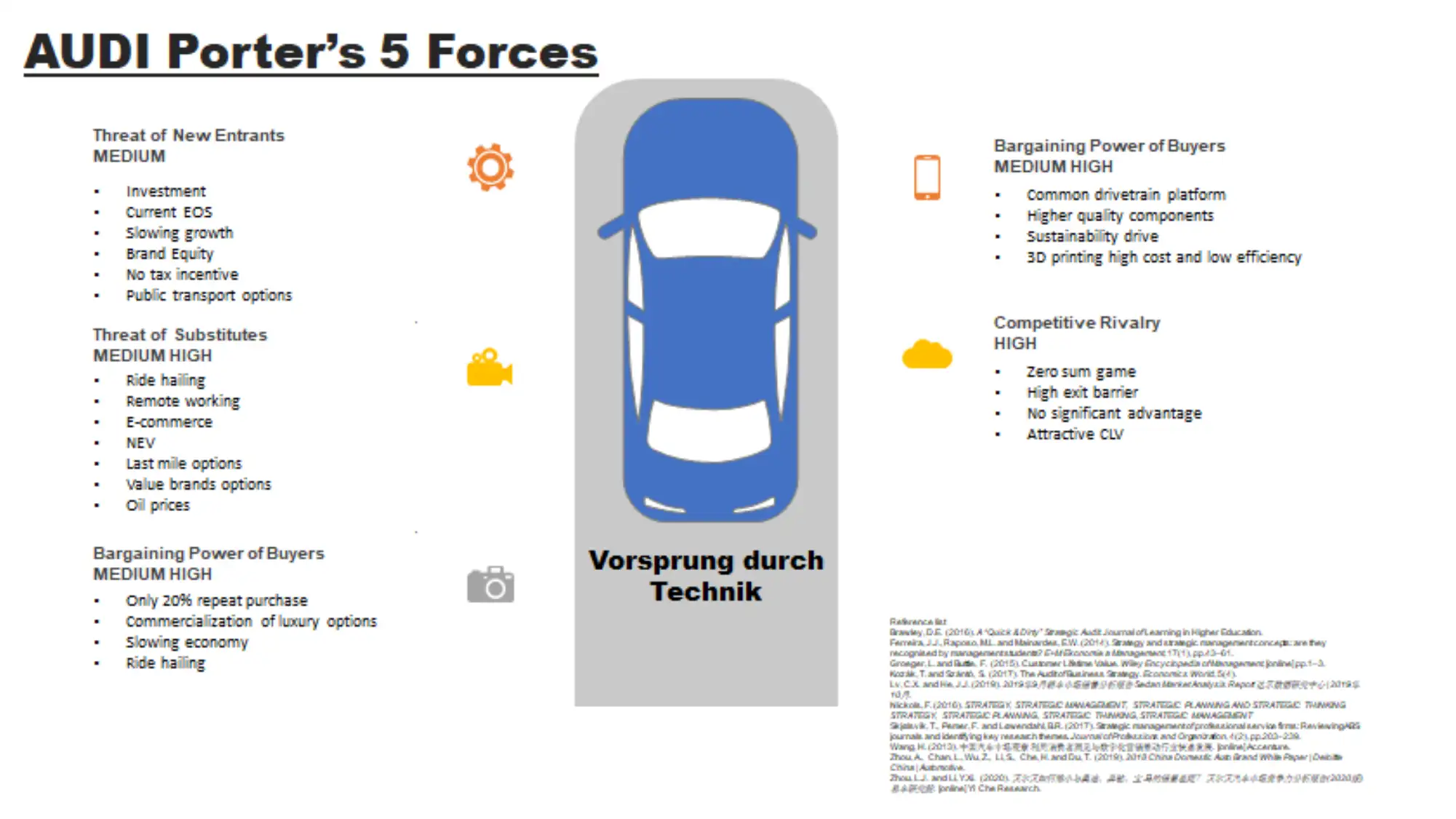
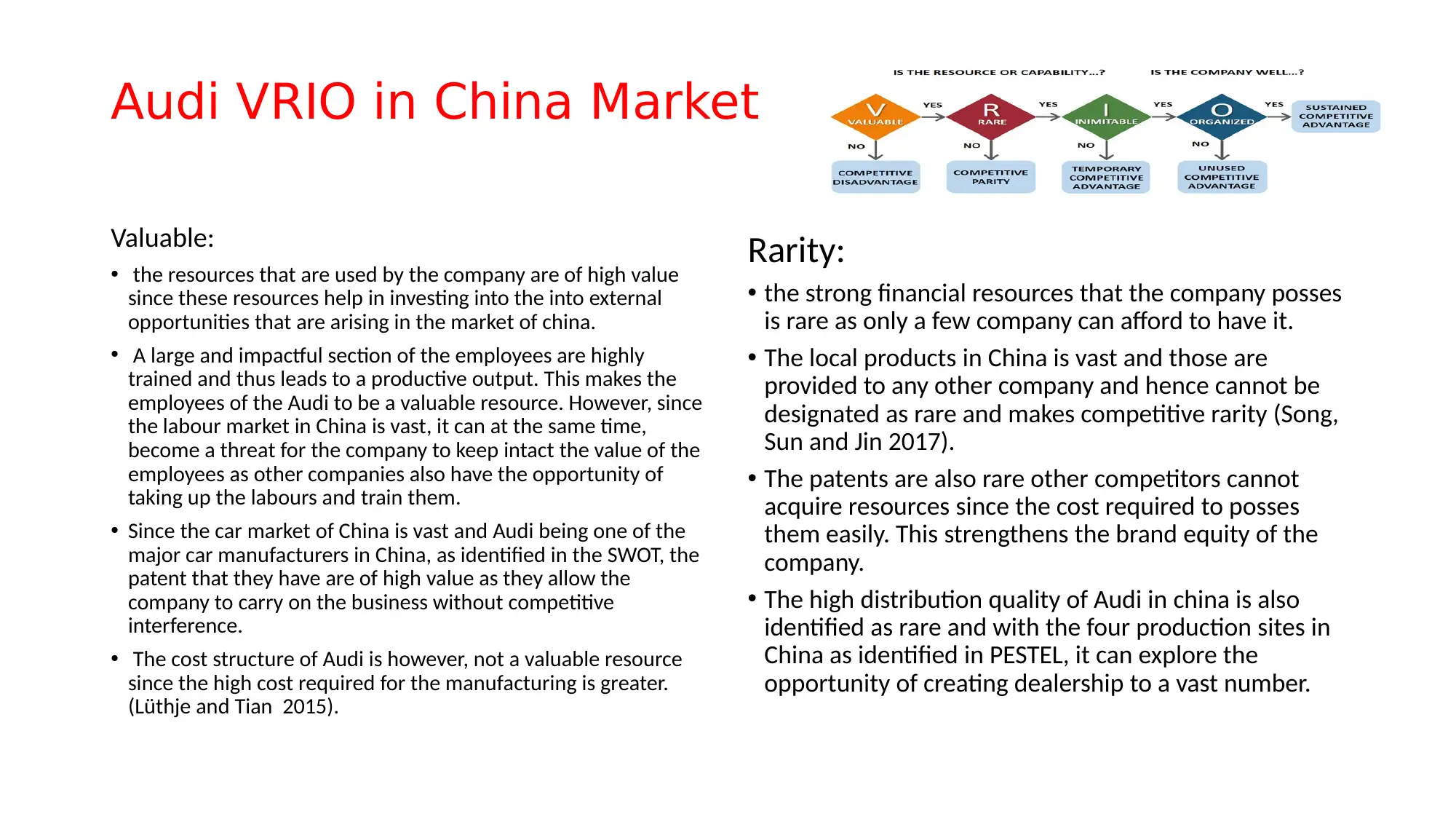
Audi VRIO in China Market
Valuable:
• the resources that are used by the company are of high value
since these resources help in investing into the into external
opportunities that are arising in the market of china.
• A large and impactful section of the employees are highly
trained and thus leads to a productive output. This makes the
employees of the Audi to be a valuable resource. However, since
the labour market in China is vast, it can at the same time,
become a threat for the company to keep intact the value of the
employees as other companies also have the opportunity of
taking up the labours and train them.
• Since the car market of China is vast and Audi being one of the
major car manufacturers in China, as identified in the SWOT, the
patent that they have are of high value as they allow the
company to carry on the business without competitive
interference.
• The cost structure of Audi is however, not a valuable resource
since the high cost required for the manufacturing is greater.
(Lüthje and Tian 2015).
Rarity:
• the strong financial resources that the company posses
is rare as only a few company can afford to have it.
• The local products in China is vast and those are
provided to any other company and hence cannot be
designated as rare and makes competitive rarity (Song,
Sun and Jin 2017).
• The patents are also rare other competitors cannot
acquire resources since the cost required to posses
them easily. This strengthens the brand equity of the
company.
• The high distribution quality of Audi in china is also
identified as rare and with the four production sites in
China as identified in PESTEL, it can explore the
opportunity of creating dealership to a vast number.
Valuable:
• the resources that are used by the company are of high value
since these resources help in investing into the into external
opportunities that are arising in the market of china.
• A large and impactful section of the employees are highly
trained and thus leads to a productive output. This makes the
employees of the Audi to be a valuable resource. However, since
the labour market in China is vast, it can at the same time,
become a threat for the company to keep intact the value of the
employees as other companies also have the opportunity of
taking up the labours and train them.
• Since the car market of China is vast and Audi being one of the
major car manufacturers in China, as identified in the SWOT, the
patent that they have are of high value as they allow the
company to carry on the business without competitive
interference.
• The cost structure of Audi is however, not a valuable resource
since the high cost required for the manufacturing is greater.
(Lüthje and Tian 2015).
Rarity:
• the strong financial resources that the company posses
is rare as only a few company can afford to have it.
• The local products in China is vast and those are
provided to any other company and hence cannot be
designated as rare and makes competitive rarity (Song,
Sun and Jin 2017).
• The patents are also rare other competitors cannot
acquire resources since the cost required to posses
them easily. This strengthens the brand equity of the
company.
• The high distribution quality of Audi in china is also
identified as rare and with the four production sites in
China as identified in PESTEL, it can explore the
opportunity of creating dealership to a vast number.
⊘ This is a preview!⊘
Do you want full access?
Subscribe today to unlock all pages.

Trusted by 1+ million students worldwide
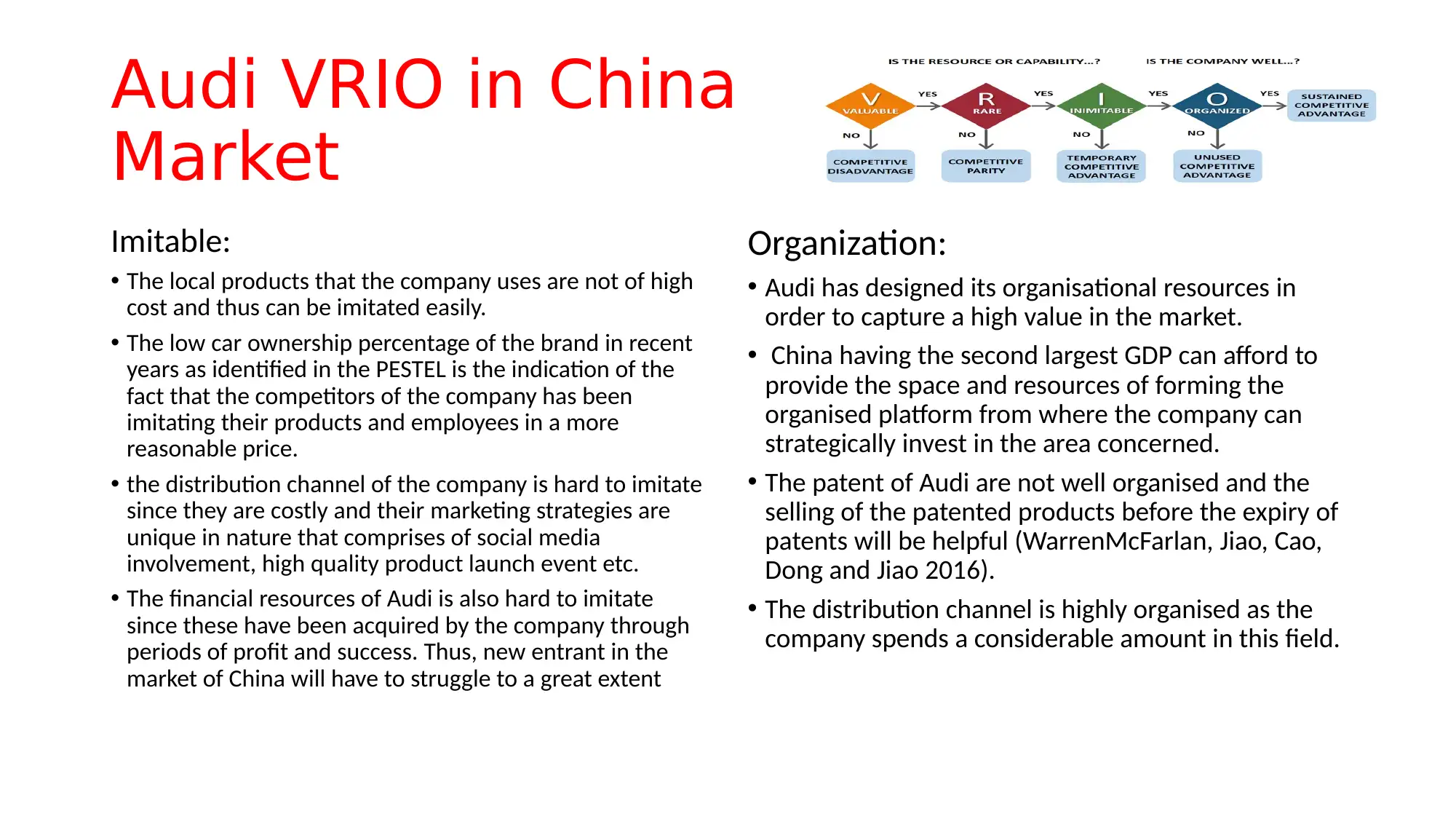
Audi VRIO in China
Market
Imitable:
• The local products that the company uses are not of high
cost and thus can be imitated easily.
• The low car ownership percentage of the brand in recent
years as identified in the PESTEL is the indication of the
fact that the competitors of the company has been
imitating their products and employees in a more
reasonable price.
• the distribution channel of the company is hard to imitate
since they are costly and their marketing strategies are
unique in nature that comprises of social media
involvement, high quality product launch event etc.
• The financial resources of Audi is also hard to imitate
since these have been acquired by the company through
periods of profit and success. Thus, new entrant in the
market of China will have to struggle to a great extent
Organization:
• Audi has designed its organisational resources in
order to capture a high value in the market.
• China having the second largest GDP can afford to
provide the space and resources of forming the
organised platform from where the company can
strategically invest in the area concerned.
• The patent of Audi are not well organised and the
selling of the patented products before the expiry of
patents will be helpful (WarrenMcFarlan, Jiao, Cao,
Dong and Jiao 2016).
• The distribution channel is highly organised as the
company spends a considerable amount in this field.
Market
Imitable:
• The local products that the company uses are not of high
cost and thus can be imitated easily.
• The low car ownership percentage of the brand in recent
years as identified in the PESTEL is the indication of the
fact that the competitors of the company has been
imitating their products and employees in a more
reasonable price.
• the distribution channel of the company is hard to imitate
since they are costly and their marketing strategies are
unique in nature that comprises of social media
involvement, high quality product launch event etc.
• The financial resources of Audi is also hard to imitate
since these have been acquired by the company through
periods of profit and success. Thus, new entrant in the
market of China will have to struggle to a great extent
Organization:
• Audi has designed its organisational resources in
order to capture a high value in the market.
• China having the second largest GDP can afford to
provide the space and resources of forming the
organised platform from where the company can
strategically invest in the area concerned.
• The patent of Audi are not well organised and the
selling of the patented products before the expiry of
patents will be helpful (WarrenMcFarlan, Jiao, Cao,
Dong and Jiao 2016).
• The distribution channel is highly organised as the
company spends a considerable amount in this field.
Paraphrase This Document
Need a fresh take? Get an instant paraphrase of this document with our AI Paraphraser
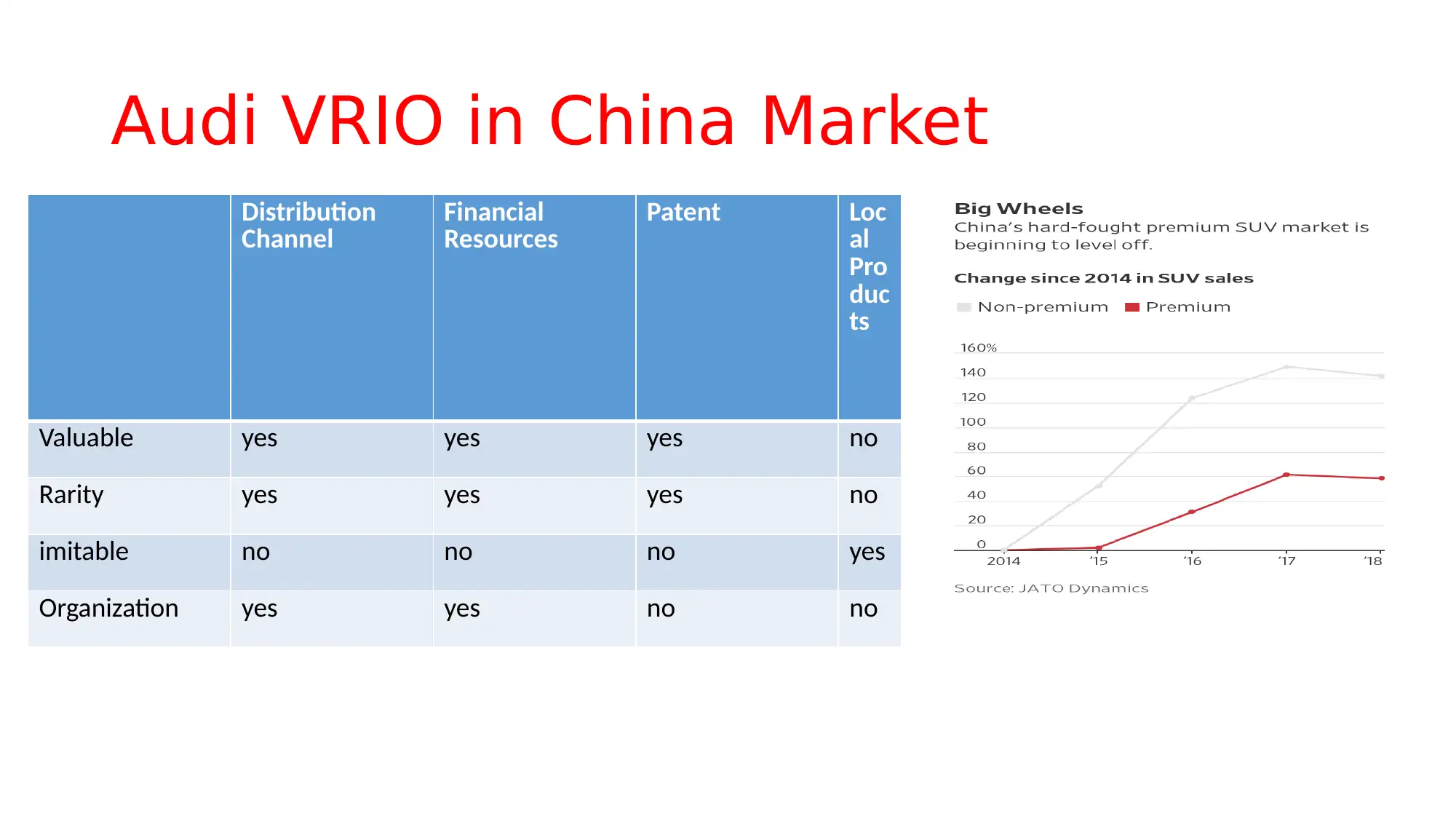
Audi VRIO in China Market
Distribution
Channel
Financial
Resources
Patent Loc
al
Pro
duc
ts
Valuable yes yes yes no
Rarity yes yes yes no
imitable no no no yes
Organization yes yes no no
Distribution
Channel
Financial
Resources
Patent Loc
al
Pro
duc
ts
Valuable yes yes yes no
Rarity yes yes yes no
imitable no no no yes
Organization yes yes no no
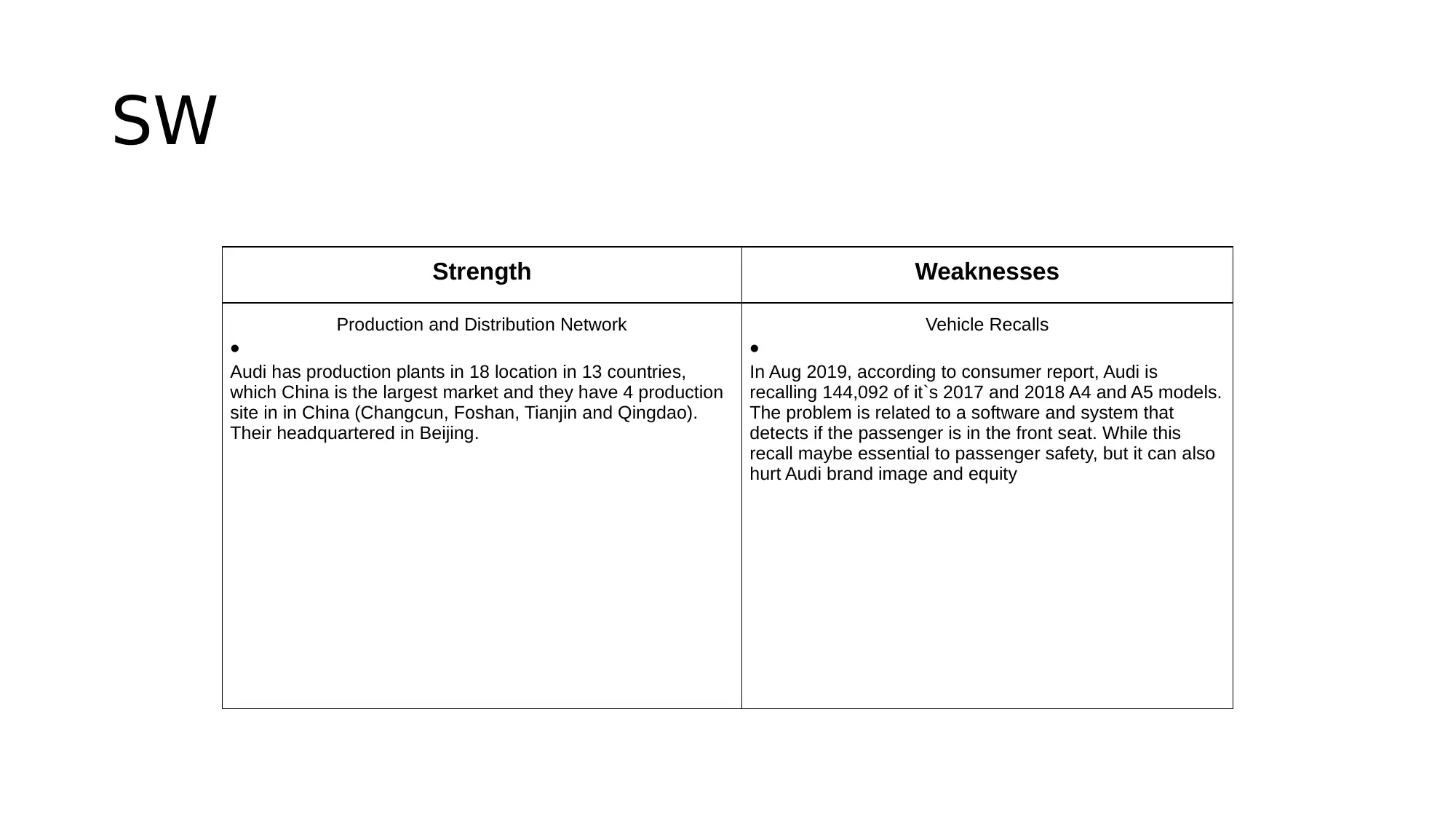
SW
Strength Weaknesses
Production and Distribution Network
•
Audi has production plants in 18 location in 13 countries,
which China is the largest market and they have 4 production
site in in China (Changcun, Foshan, Tianjin and Qingdao).
Their headquartered in Beijing.
Vehicle Recalls
•
In Aug 2019, according to consumer report, Audi is
recalling 144,092 of it`s 2017 and 2018 A4 and A5 models.
The problem is related to a software and system that
detects if the passenger is in the front seat. While this
recall maybe essential to passenger safety, but it can also
hurt Audi brand image and equity
Strength Weaknesses
Production and Distribution Network
•
Audi has production plants in 18 location in 13 countries,
which China is the largest market and they have 4 production
site in in China (Changcun, Foshan, Tianjin and Qingdao).
Their headquartered in Beijing.
Vehicle Recalls
•
In Aug 2019, according to consumer report, Audi is
recalling 144,092 of it`s 2017 and 2018 A4 and A5 models.
The problem is related to a software and system that
detects if the passenger is in the front seat. While this
recall maybe essential to passenger safety, but it can also
hurt Audi brand image and equity
⊘ This is a preview!⊘
Do you want full access?
Subscribe today to unlock all pages.

Trusted by 1+ million students worldwide
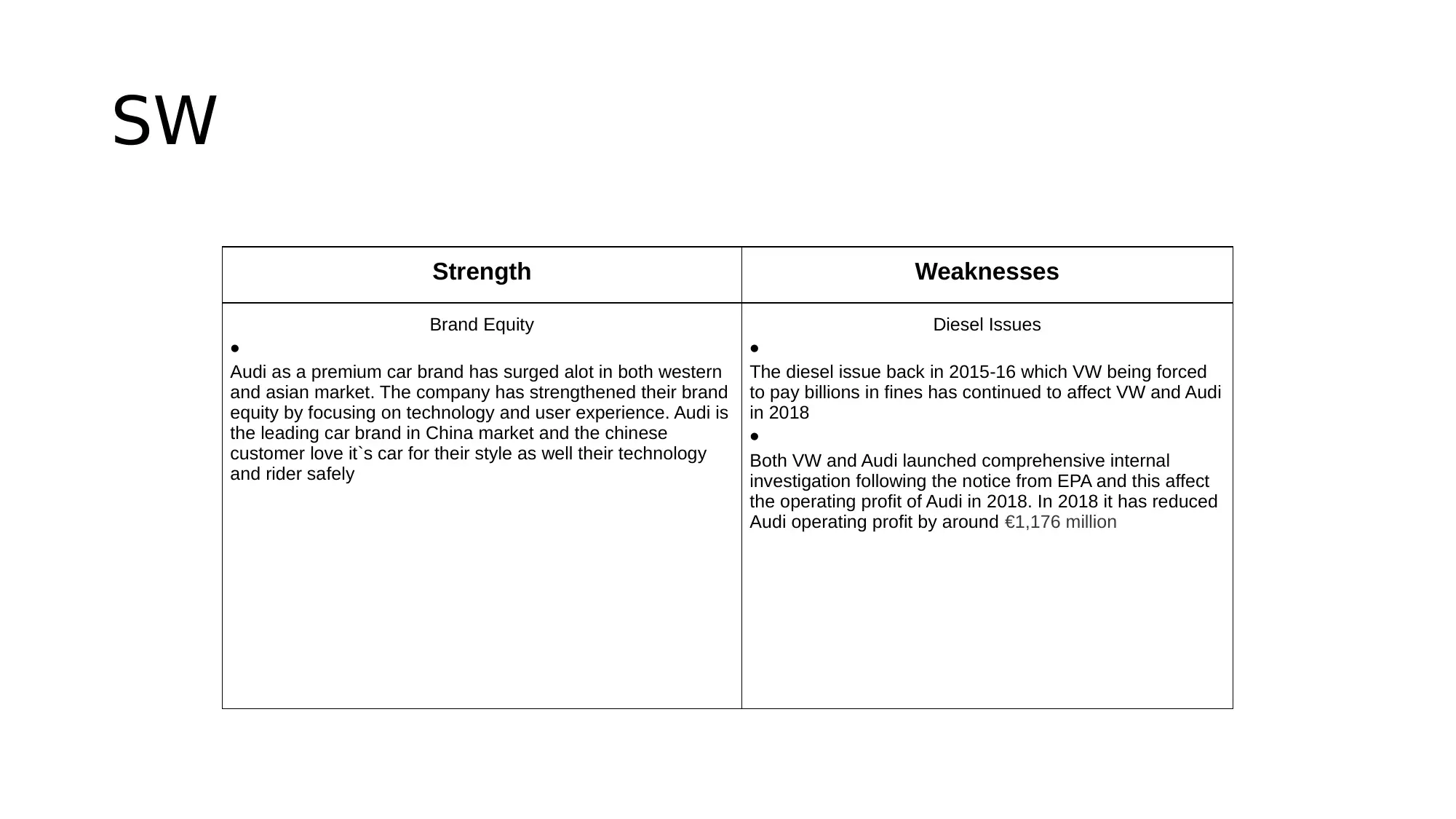
SW
Strength Weaknesses
Brand Equity
•
Audi as a premium car brand has surged alot in both western
and asian market. The company has strengthened their brand
equity by focusing on technology and user experience. Audi is
the leading car brand in China market and the chinese
customer love it`s car for their style as well their technology
and rider safely
Diesel Issues
•
The diesel issue back in 2015-16 which VW being forced
to pay billions in fines has continued to affect VW and Audi
in 2018
•
Both VW and Audi launched comprehensive internal
investigation following the notice from EPA and this affect
the operating profit of Audi in 2018. In 2018 it has reduced
Audi operating profit by around €1,176 million
Strength Weaknesses
Brand Equity
•
Audi as a premium car brand has surged alot in both western
and asian market. The company has strengthened their brand
equity by focusing on technology and user experience. Audi is
the leading car brand in China market and the chinese
customer love it`s car for their style as well their technology
and rider safely
Diesel Issues
•
The diesel issue back in 2015-16 which VW being forced
to pay billions in fines has continued to affect VW and Audi
in 2018
•
Both VW and Audi launched comprehensive internal
investigation following the notice from EPA and this affect
the operating profit of Audi in 2018. In 2018 it has reduced
Audi operating profit by around €1,176 million
Paraphrase This Document
Need a fresh take? Get an instant paraphrase of this document with our AI Paraphraser
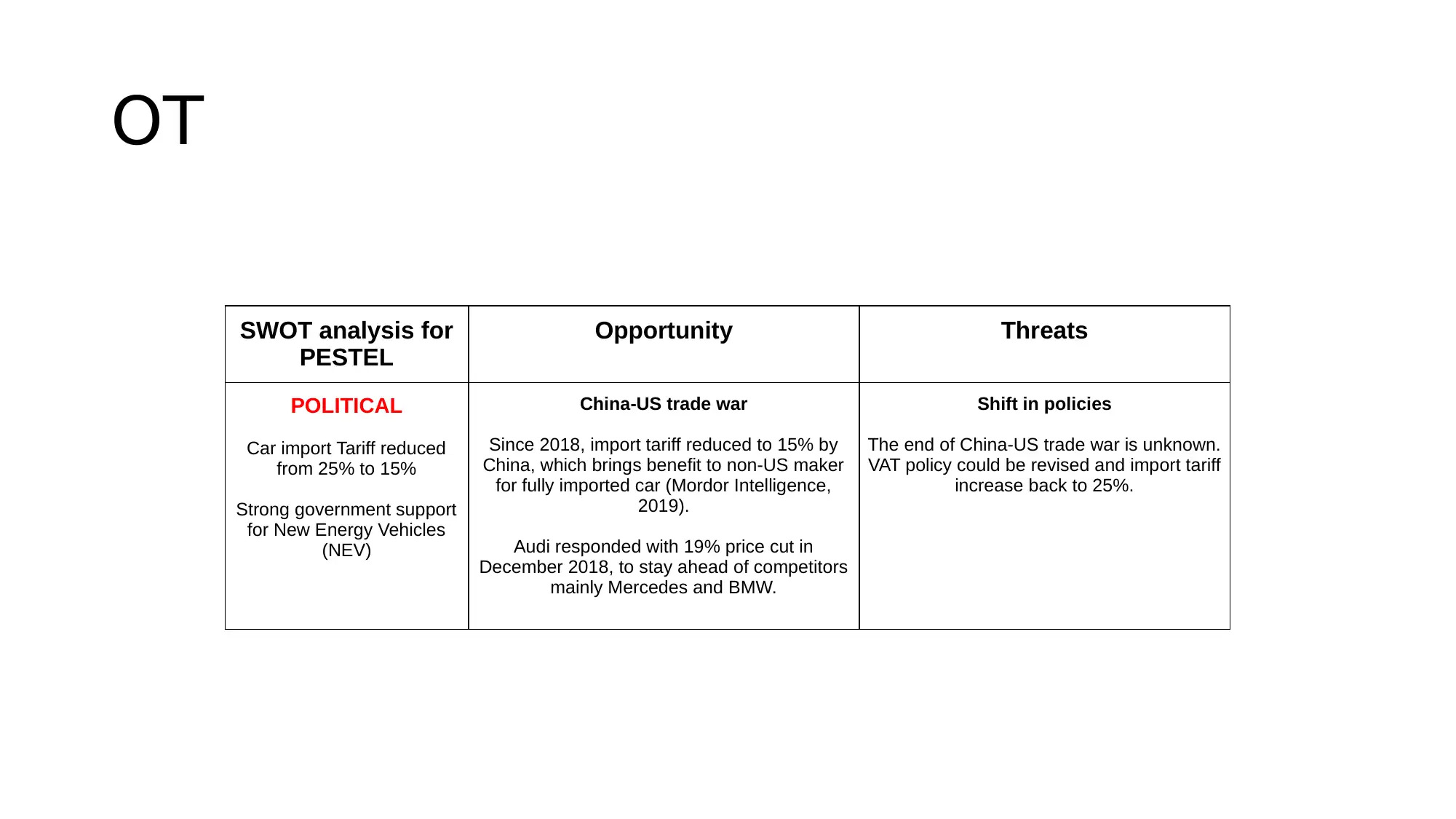
OT
SWOT analysis for
PESTEL
Opportunity Threats
POLITICAL
Car import Tariff reduced
from 25% to 15%
Strong government support
for New Energy Vehicles
(NEV)
China-US trade war
Since 2018, import tariff reduced to 15% by
China, which brings benefit to non-US maker
for fully imported car (Mordor Intelligence,
2019).
Audi responded with 19% price cut in
December 2018, to stay ahead of competitors
mainly Mercedes and BMW.
Shift in policies
The end of China-US trade war is unknown.
VAT policy could be revised and import tariff
increase back to 25%.
SWOT analysis for
PESTEL
Opportunity Threats
POLITICAL
Car import Tariff reduced
from 25% to 15%
Strong government support
for New Energy Vehicles
(NEV)
China-US trade war
Since 2018, import tariff reduced to 15% by
China, which brings benefit to non-US maker
for fully imported car (Mordor Intelligence,
2019).
Audi responded with 19% price cut in
December 2018, to stay ahead of competitors
mainly Mercedes and BMW.
Shift in policies
The end of China-US trade war is unknown.
VAT policy could be revised and import tariff
increase back to 25%.
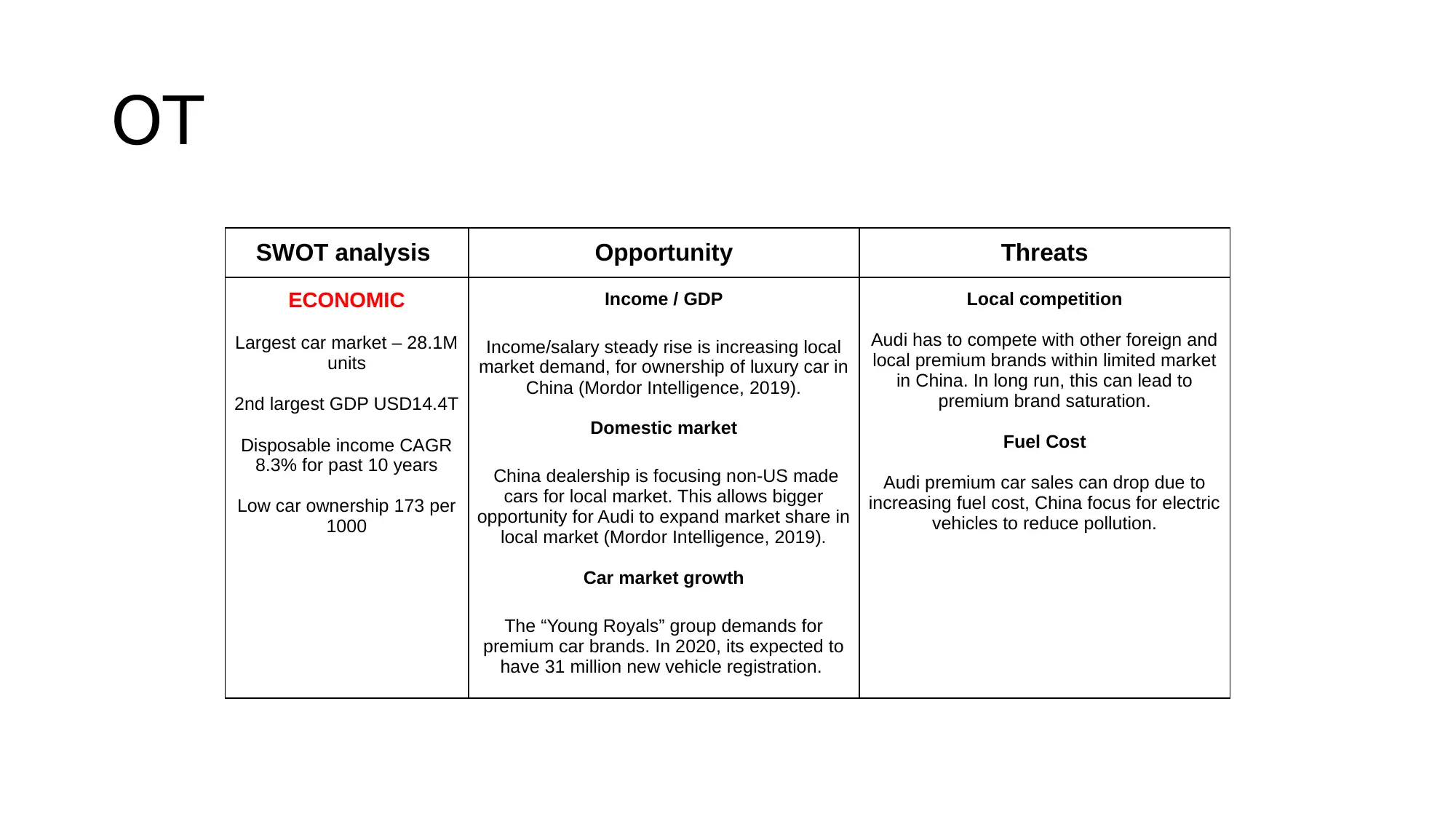
OT
SWOT analysis Opportunity Threats
ECONOMIC
Largest car market – 28.1M
units
2nd largest GDP USD14.4T
Disposable income CAGR
8.3% for past 10 years
Low car ownership 173 per
1000
Income / GDP
Income/salary steady rise is increasing local
market demand, for ownership of luxury car in
China (Mordor Intelligence, 2019).
Domestic market
China dealership is focusing non-US made
cars for local market. This allows bigger
opportunity for Audi to expand market share in
local market (Mordor Intelligence, 2019).
Car market growth
The “Young Royals” group demands for
premium car brands. In 2020, its expected to
have 31 million new vehicle registration.
Local competition
Audi has to compete with other foreign and
local premium brands within limited market
in China. In long run, this can lead to
premium brand saturation.
Fuel Cost
Audi premium car sales can drop due to
increasing fuel cost, China focus for electric
vehicles to reduce pollution.
SWOT analysis Opportunity Threats
ECONOMIC
Largest car market – 28.1M
units
2nd largest GDP USD14.4T
Disposable income CAGR
8.3% for past 10 years
Low car ownership 173 per
1000
Income / GDP
Income/salary steady rise is increasing local
market demand, for ownership of luxury car in
China (Mordor Intelligence, 2019).
Domestic market
China dealership is focusing non-US made
cars for local market. This allows bigger
opportunity for Audi to expand market share in
local market (Mordor Intelligence, 2019).
Car market growth
The “Young Royals” group demands for
premium car brands. In 2020, its expected to
have 31 million new vehicle registration.
Local competition
Audi has to compete with other foreign and
local premium brands within limited market
in China. In long run, this can lead to
premium brand saturation.
Fuel Cost
Audi premium car sales can drop due to
increasing fuel cost, China focus for electric
vehicles to reduce pollution.
⊘ This is a preview!⊘
Do you want full access?
Subscribe today to unlock all pages.

Trusted by 1+ million students worldwide
1 out of 17
Related Documents
Your All-in-One AI-Powered Toolkit for Academic Success.
+13062052269
info@desklib.com
Available 24*7 on WhatsApp / Email
![[object Object]](/_next/static/media/star-bottom.7253800d.svg)
Unlock your academic potential
Copyright © 2020–2025 A2Z Services. All Rights Reserved. Developed and managed by ZUCOL.





